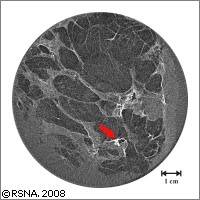New tool for the early detection of breast cancer
An EU-funded study has demonstrated a new technique that could be used for the early detection of breast cancer. Scientists from Finland, France and Germany used three-dimensional X-ray analysis to obtain a high-resolution, high-contrast image of the breast that is extremely sensitive to changes in the tissue, such as those that might be caused by a tumour. Their findings mark a significant improvement in the state of the art of X-ray mammography. Breast cancer, which forms in tissues of the breast (typically the milk ducts and milk-producing glands), is the second most common type of cancer after lung cancer and the fifth most common cause of cancer death. It is widely recognised that the early detection of breast cancer is directly linked to successful treatment of the disease. Diagnostic mammography and CT (computed tomography) scans are typically used to screen for tumours in the breast. However, the resulting images are often unclear: X-ray mammography fails to identify approximately 10 to 20 percent of palpable breast cancers. The current study found that sharper, higher-contrast images could be attained using high-spatial-resolution, low-dose, analyser-based X-ray CT imaging, also referred to as ABI. The researchers examined an excised human breast tumour. The tissue they looked at had been invaded by a diffusely growing cancer called a lobular carcinoma, the second most common form of breast cancer. The extension of this kind of cancer is frequently missed by X-ray mammography and ultrasound. They compared ABI scans of the tissue with those from diagnostic mammography, conventional CT and histopathology. ABI provided exceptional clarity, distinguishing more microcalcifications (small deposits of minerals indicating the presence of cancer) than the other radiography methods. The success of ABI in producing high-contrast images where the tissue is smooth and variations subtle is remarkable. 'Calcifications and fine details of soft tissue, which are at the contrast detection limit on diagnostic mammograms, are clearly visible on planar analyser-based X-ray images,' explains Jani Keyriläinen of Turku University Central Hospital in Finland and the main author of the paper. 'If we compare the images with X-ray mammograms and conventional CT images, we can confirm that this technique performs extremely well.' The visualisation was achieved using a dose of radiation similar to that used in a normal mammography examination, and the spatial resolution of the images was estimated by the researchers to be seven times better than that achieved by a conventional CT scanner. The improved visibility offered by ABI has implications for the early diagnosis of breast cancer. However, further investigations are needed to make this valuable diagnostic method available for clinical applications. Dr Alberto Bravin of the European Synchrotron Radiation Facility said, 'The technique does not require sophisticated and expensive synchrotron radiation facilities... [However,] it would not be viable to use X-ray tubes, as exposure times would be too long and this would be incompatible with clinical practice.' The research team hopes that the development of compact, highly intense X-ray sources will enable the clinical use of ABI. Dr Bravin commented, 'With these machines it would definitely be possible to apply this technique to clinical practice and, in this way, contribute actively to a more efficient detection of breast cancer'. EU support for the study came from the PHASY ('Phase analyzer system for novel imaging modalities') project, which was financed under the 'Improving human research potential and the socio-economic knowledge base' Horizontal Programme of the Fifth Framework Programme (FP5).
Countries
Germany, Finland, France



